Occassional thoughts about orienteering
| okansas.blogspot.com Occassional thoughts about orienteering |
|
Tuesday, October 31, 2006 Some mathDoes 1 x 5 = 10 x 0.5?Is making one 5 minute boom the same as making 10 30 second booms? I was thinking about this in two contexts: (a) Which of those two alternatives "feels" better? Both have the same final impact (i.e. five minutes lost), but they might not have the same mental impact. (b) If you were looking at splits from two juniors, one who made a 5 minute boom and one who made 10 30 second booms, which would you think was likely to become a better orienteer? That's the sort of thing I think about when I'm sitting in a hotel room on a business trip. posted by Michael | 6:27 PM Sunday, October 29, 2006 okansas.blogspot.com #4Gabcast! okansas.blogspot.com #4 posted by Michael | 9:49 PM On the Road = irregular updates the next weekI've got a work trip and probably won't be updating this page each day. posted by Michael | 1:36 PMSaturday, October 28, 2006 Reminds me of somethingThe maps from Ukraine that Oystein Kvaal Osterbo posted remind me of something. But, I can't think of what. I've never run in Ukraine. But, there is something about these maps that looks vaguely familiar. Maybe I'm just cracking up.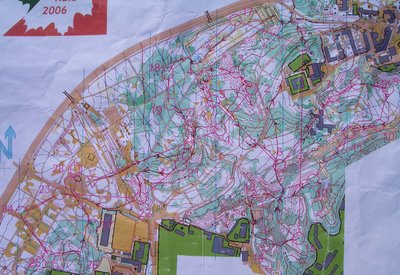 To my eye, some of the map above looks a bit like some areas in Ohio. I'm thinking of the contours, in particular. The map below is really unusual looking. Those earth banks dominate your first look at the map. Those earth banks must be fairly large. You can see a number of passages that go under them (take a look at the route from 9 to 10, for example). The symbol is a bit hard for me to make sense of at a quick glance. It probably wouldn't be hard with a bit of practice, but when you're not familiar with this stuff, it is tricky.  posted by Michael |
8:03 PM
posted by Michael |
8:03 PMFriday, October 27, 2006 Some inspirationWatch Billy Mills win Olympic Gold in the 10,000 meters.Now, read the interview with Billy in my hometown newspaper. And for more inspiration, check out what Alessio Tenani designed for some indoor O' training. That looks fun. posted by Michael | 7:35 PM Thursday, October 26, 2006 "Can passion be taught?"From an interview with Ferdinand Metz:"So, I would say those are the three components: basic understanding, passion, and balance." Metz was talking about culinary education, but as I read the interview it struck me as sounding a lot like any education that is leading to high performance, like, for example, orienteering. The entire interview is quite interesting (it is in the latter parts of Michael Ruhlman's The Making of a Chef), but I was particularly interested in Metz' comments on passion. "Passion" is analogous to the drive, the motivation, that orienteers need to be their best. It might be the difference between the top juniors who stick with it and go on to better results and the top juniors who drift out of the sport. I've got some theories about how to create, or maybe just unleash, some of the drive/motivation/passion (long time readers might recall my theory of being able to "tell your story."). I was particularly interested when the Metz interview included this exchange: "On top of it, the one word, again, is passion. Seeking more knowledge each and every day, doing more things each and every day." ... "Can passion be taught?" I [Ruhlman] asked Metz. "Yes," he said. "By example. Not by talking about it. By example. Absolutely. If the stdents are involved with a teacher who, when he or she talks about a fresh herb and what that means, and begins to become excited by this silly little fresh herb, that's passion. If they see that that person, being more mature and more experienced, still gets enjoyment by being able to focus on that, understanding and appreciating the difference that makes in his or her cooking, I think, yeah, by example it can be learned." When I read that passage from the Metz interview, I immediately thought about how motivating it has been to be around really good orienteers and see their "passion." I still have a very strong memory of running with the great Swiss orienteer, Dieter Wolfe, on a map just outside of Kansas City. It must have been in 1983 or so. I felt a bit disappointed to have to show him our less-than-impressive terrain. But, as soon as he came out of the (thick) forest, he was all smiles, saying "that was really fun." Here was a great orienteer, bashing around in crappy forest and uninteresting terrain, but having fun because...well, because it was orienteering and he had the passion that Metz talks about. posted by Michael | 9:06 PM Wednesday, October 25, 2006 "John Fredrickson Intervals"I'm a firm believer in doing some stupid training now and then. By "stupid" I mean something that doesn't fit with your plan, isn't something that you intent to regularly incorporate in your training, and isn't something you'd recommend to others. But it might be fun and you've got to experiment now and then - do something you might not otherwise do. Tonight, I did some stupid training.I ran "John Fredrickson Intervals." John is, as you may know, one of the best orienteers in the U.S. He's coming of a big win at the North American Champs where he won the M21 middle distance race. John is still a junior. So, he's 20+ years younger than me. It goes without saying that he is faster than I am. He's probably also faster than I ever was (I got just under 17 minutes for 5,000 meters; I'd guess John could run about 16 minutes). John passed through Kansas City a few months ago and ran my test loop. Not only did he run my test loop and set the current record, but he also took splits. I ran the test loop, trying to beat John's splits, but taking as much rest as I needed at each control. The idea was to see what it would feel like for my old legs to move at John's speed. I took off toward the first control, a short leg that John ran in 26 seconds. I ran hard, but not a flat out sprint. I punched my watch at 28 seconds. I was already behind. The next leg was a bit longer, taking John 2:05. I stopped my watch at 2:07, bent over and gasped for breath. Already, I was 4 seconds off John's time. I was worried. I needed to be a good 4-5 seconds ahead of him at the last control. I knew I couldn't run the finish chute as fast as John. I needed to have some seconds in the bank near the end of the course. I pushed hard on the third leg - close to a flat out sprint. Yes! I got John by 7 seconds on the leg (putting me up by 3 seconds). I worked my way around the course, running each leg hard and then comparing my time to John's in the minute or so that I rested at each control. Fortunately for me, John began a bit fast and his pace eased off a little after a few minutes of running. I had to work hard, but at the end my split times added up totaled 12:40. John's time for the course totaled 12:46. I'd call it a stupid training, but I learned what I set out to learn - what it'd feel like to move at John's pace. posted by Michael | 10:03 PM Tuesday, October 24, 2006 New Project? Mountain Bike O' Map? I spent a couple of hours on Sunday exploring an area that has some potential to be a new orienteering area. I'm thinking that I might start by mapping it as a mountain bike O' area. I spent a couple of hours on Sunday exploring an area that has some potential to be a new orienteering area. I'm thinking that I might start by mapping it as a mountain bike O' area.Although the area is small, I think it'd make for a nice short or sprint course area, and even then you'd probably have to have a map change. What would make the area good for mountain bike O' is that there is a dense network of bike trails. Most of the trails are smooth single track, but there is also a large paved trail through the entire area. The forest is typical for the KC-area. A few areas are nice, open forest (see the photo below). But, most of the forest is thick (and some of it is very thick). Old farm fields make up a fair chunk of the area. But, it looks like the farm fields aren't going to be maintained by burning or mowing. They're already getting overgrown with dense tall grass. Fortunately, the dense trail network would mean an orienteer wouldn't be forced to spend time in the worst of the vegetation. The photo below shows one of the nicer hillsides with open forest and beautiful fall colors. The photo at the top of the page shows the paved bike trail in the background.  Here is the map I carried when I explored the area. The contours are from USGS with many of the bike trails added. The map is superimposed over a air photo that gives you an idea of the mix of fields and forest.  posted by Michael |
8:32 PM
posted by Michael |
8:32 PMMonday, October 23, 2006 Forecasting success: part IIIA little thought experiment in forecasting future success...Think of three junior runners from the U.S.: A, B and C. They run a 2-day race. The terrain is difficult. Let's say the terrain is not just difficult, but unusual. The terrain is forested sand terrain, with lots of depressions and knolls, but also a decent trail network. On the first day the results are like this: 1st B in 70 minutes 2nd A in 75 minutes 3rd C in 90 minutes On the second day the results are like this: 1st A in 60 minutes 2nd B in 70 minutes 3rd C in 65 minutes And the two day total time puts the runners in order A, B and C. Gold medal to A in 135 minutes. Silver medal to B in 140 minutes. Bronze medal to C in 155 minutes. I'll throw in another bit of information. If you put these 3 runners on a track and had them race for 5,000 meters, A would win. C would be a minute or so back, and B would be another minute or so back. So, you've got the results and you know that in pure running speed, A is fastest and B is slowest. I'll throw in another bit of information. A's parents are involved in orienteering. They travel to meets and compete a lot. B's and C's parents aren't nearly as involved, but they certainly support their kids' orienteering. Which of them will be most successful as a senior? At this point, you could make a guess and you could probably create a line of thinking to support the idea that any one of these three runners would go on to more success. If I told you that the answer was A, you might say: Yes, A, of course. It is obvious. A is faster, he's got the physical talent. He won the race - he performed best when it counted. His parents are really supportive. But, if I told you that the answer was B, you might say: Yes, B, of course. B showed a real consistency. His foot speed is lacking, but with some serious training, that could be fixed. Or, if I told you the answer was C, you might say: Yes, C. C had a bad first day, but came back pretty strong on the second day. That shows some character. His running is decent and with some better training he'd be faster. I guess my point is that it is very easy to go backward - from an answer to an explanation. It is much harder to, reliably, go forward - to look at some information and predict future success. I should also admit that this little scenario is based on three actual orienteers and a 2-day race that happened years ago. I should probably share the real answer - A, B or C - but I think I'll wait for a few days. That's enough writing for tonight, the football game ("Go Giants!") is about to start. posted by Michael | 7:14 PM Sunday, October 22, 2006 The Dog OrienteerI watched a bit of The Dog Whisperer on TV tonight. It followed the standard Dog Whisperer story line - one of the dogs had all sorts of bad habits that seemed to just disappear as soon as Cesar calmed the dog down and walked him through his pack at the dog psychology center. Cesar said something that struck me; something like, "the dog doesn't remember the past, he just lives in the present."Wouldn't that be great? To just "live in the present" and not remember bad habits. I seem to have a habit of trying to run hard during races. It isn't every race, but it happens enough that I have a couple of bad races each year because I forget to just read the map. If I was a dog, maybe I wouldn't have that problem...or maybe I'd never break the bad habit... posted by Michael | 7:55 PM Local race in the rain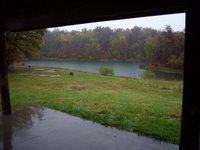 The local O' season began yesterday with a rainy course at Blue and Gray. The park gets a lot of use from horse riders. The rain was a mixed blessing. It kept the riders away for the day, but it made the trails slick and muddy. The local O' season began yesterday with a rainy course at Blue and Gray. The park gets a lot of use from horse riders. The rain was a mixed blessing. It kept the riders away for the day, but it made the trails slick and muddy.Running on the trails was tricky. When you pushed off, you foot would slide a bit. When you landed, your foot would slide a bit. It felt like a harder effort wouldn't necessarily lead to moving faster. Maybe that is what it is like to ski cross country with bad wax. A few years ago an ice storm hit the park. In places you still see evidence of the storm. I came across a few spots with a lot of downed trees. But, the most visible damage is that a lot of the trails have been changed just a little bit. When the storm knocked a tree down over a trail, it was common that the riders just moved the trail a bit to avoid the tree. Years later, the original trail is gone, but the re-routed trail is so close that you might not notice the difference. When you run trails at Blue and Gray, you need to keep that in mind and pay attention more than you might otherwise.  From what I've written, a good strategy might seem to be to avoid the trails. But, that wouldn't be right - the forest in the park is thick. And, while the vegetation isn't at summer-levels, the vegetation hasn't yet gone back to winter levels.  I like this kind of course setting for this kind of event. The controls locations were simple. But you faced some route choice problems. Too often, local course setters pick interesting, tricky control locations, but problems with the map (or with hanging the markers) make those locations weak. Dinner? I put together a baked goat cheese salad with pears and almonds. Yum.  posted by Michael |
9:01 AM
posted by Michael |
9:01 AMFriday, October 20, 2006 Home decorating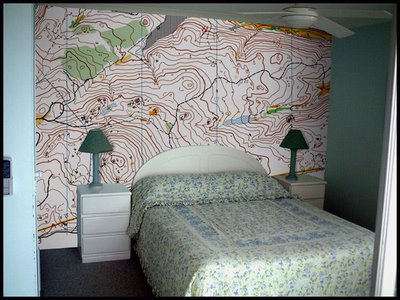 Aspleaf spent some time playing around with Photoshop and doing some home decorating. This is how I want my room to look (and I bet Mary would go along with it). I wonder how I'd go about getting an OCAD map blown up to wall size? posted by Michael | 7:25 PM Thursday, October 19, 2006 "No thanks" to the Norwegian elite groupOystein Kvaal Osterbo wrote about why he said "no thanks" to being in the Norwegian elite group. If you can read Norwegian, check out what he wrote. If you can't read Norwegian, I'll give you a very quick, rough summary (not a translation) of why he turned down the elite group.Being part of the elite group leave little range for individual adjustments. The group is expected to go to specific training camps and use the Norwegian team coach. Don't worry about him giving up on elite orienteering. He makes in clear that he's motivated and will train hard. He's also been selected as part of a special group of Norwegian's who are part of a special national team project to prepare for the 2010 WOC in Norway. If you don't check Oystein Kvaal Osterbo's web page on a regular basis, you should. He usually writes in English. He also posts lots of maps and photos. posted by Michael | 8:47 PM Wednesday, October 18, 2006 Forecasting success: part IIBernt O. Myrvold, from Norway, spent some time thinking about the question of forecasting success from the results of young orienteers. He put together a spreadsheet that shows the year top Norwegians won championships as young runners. For example, Hanne Staff was born in 1973 and won a championship in 1990 (she also won championships in 1991 and 1992).Bernt's spreadsheet is full of interesting data. As another example, here is a list of Norwegian orienteers who were born in 1974 who won various age group championships through 1994: Morten Skogsfjord Anders Storbraten (3 wins) Pal Johansen Tomas Edvardsen Truls A Veslum (2 wins) Erik Paulsrud Geir Solerod Olav Snildal Erik Paulsrud Morten Skogsfjord Odin Tellesboe Geir Solerod Viggo Molund Holger Hott Johansen Bernt was interested in relating success as a 14-16 year-old and seeing if it would predict success as a 17-20 year-old. He saw: Of the 80 runners that took a medal when they were 14-16 only 15 took a medal when they were 17-20. E.g. an awful lot of false positives. Of the 41 runners that took a medal when they were 17-20 only 15 had taken a medal when they were 14-16. E.g. an awful lot of false negatives as well. A fascinating question is: When they were both 20 and winning Norwegian Championships, would it be possible to look at Viggo Molund and Holger Hott Johansen and predict their future success? Both Viggo and Holger are very good orienteers, but their careers as seniors have been quite different. You can get a good sense of their O' careers by looking at their Norwegian Champs histories: check out Viggo Molund and Holger Hott Johansen. I could write more. This is a fascinating topic. But dinner is ready. posted by Michael | 7:18 PM Tuesday, October 17, 2006 A sprint leg I see four options on 9 to 10: 1. Left of the line, behind the first building, across the paved area to the control. 2. Straight east, by the first building, then north between buildings and back east to the control. 3. Straight east, by the first two buildings, then north between the two buildings (under the canopy) and to the control 4. Same as route 3, but missing the narrow gap and ending up running all the way around the last building and taking the control from the east. I'd guess that route 3 is fastest, if executed perfectly. But, someone running route 3 would risk losing time to notice the gap between the buildings on the map and in the terrain. They'd run a small risk of missing that gap and winding up running route 4. Routes 1 or 2 are, I'd guess, a few seconds slower than route 3. But, both are safe. Easy to read on the map. Easy to read the terrain. Little risk of a mistake. This kind of orienteering is a classic urban sprint O' problem. And the solution - recognizing that you've got to consider trade offs between the optimal route if executed perfectly and the probability of a big mistake. It is the same sort of problem you face where you're orienteering in the forest, but the type of mistake that you've got to consider is a little bit different. You've got to look at sprint maps to start to recognize those kind of problems (and to start seeing the solutions to those problem). This leg, by the way, decided the elite women's race at the North American Champs. Here are the top three results from that race: Katarina Smith 15:01 Louise Oram 15:20 Samantha Saeger 15:23 On leg 9 to 10: Louise lost 16 seconds to Katarina Samantha lost 53 seconds to Katarina posted by Michael | 8:21 PM Monday, October 16, 2006 Forecasting successI've been thinking about how orienteers develop and about the idea of forecasting success. I've always thought it was interesting that there is clearly a relationship between being a good junior orienteer and being a good senior orienteer, but that the relationship isn't necessarily straightforward.In the last week+ I've come across the basic ideas of forecasting in three disparate contexts. 1. I had a chat at the North American Champs about Bill James and, in particular, his ideas about relating minor league baseball stats and major league performance. 2. At the conference in Denver last week, I went to a presentation by researchers who are looking at forecasting murder. They're analyzing information to try to identify characteristics of offenders that can be used to predict that those offenders will not only offend again, but offend again by killing someone. That's a lot more serious and important than orienteering, but there are probably some interesting parallels (not so much in characteristics as in the approach to thinking about the problem). 3. I read about a talk Malcolm Gladwell gave on his experiences as a runner and some general thoughts about young progidies. Gladwell's stories reminded me of something Peter Snell told me. Peter said that two runners in his school were better than him at 800 meters. It wasn't much longer, however, before Peter was the best 800 meter runner in the world. Can you look at how a junior orienteers and predict future performance at a high level? Can you do it without a lot of "false positives"? I don't know the answer to those questions, though I've got a few ideas. Maybe that's a topic for tomorrow... posted by Michael | 7:54 PM Sunday, October 15, 2006 Mystery solved...maybeA press release from Orienteering Today just appeared. I'd heard some rumors (maybe even spread some myself) about the shaky economic state of the magazine. The latest press release gives those of us who are O' Today fans hope. You can read the press release.I sure hope the changes do two things: 1. Keep the magazine afloat. 2. Allow the magazine to keep providing good content. We shall see. Some Snapshots from Canada I finally downloaded a few snapshots from Canada. First up, a control the forest, with plenty of ankle twisting rocks. 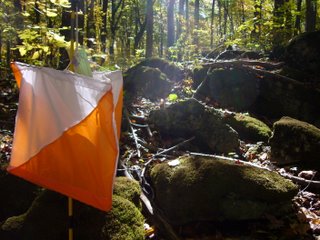 A trail through the fall colors...  And last, is that Dylan's T-shirt or something else?  posted by Michael |
7:32 PM
posted by Michael |
7:32 PMSaturday, October 14, 2006 Cooking and orienteering continued...Another quote from the book I'm reading:I asked Felder if she thought great cooking was innate or could be learned. "This is the million-dollar question," she said, "and I get in so much trouble with this one. I believe that cooking is a craft. And it's a craft that can be taught, it's a skill that can be taught. I do not believe it's an art. I think that if you have a good positive attitude and drive and focus and have your eyes set on a goal, then you can be trained to cook. If the passion is there. You have to have that passion, because it's hard work, it's hard on your body. It's hard. It's very physical." Well, replace "cooking" with "orienteering" and you've got some very relevant stuff for those of us interested in orienteering. posted by Michael | 7:56 PM Thursday, October 12, 2006 posted by Michael | 10:05 PM Wednesday, October 11, 2006 To ColoradoI'm leaving for a work trip to Colorado in a few minutes. Don't assume I'll update this page daily until Saturday, october 14, (though I might get around to posting a note or two). posted by Michael | 1:49 PMTuesday, October 10, 2006 What can the CIA teach an orienteer?No, not that CIA; I'm talking about the Culinary Institute of America.I'm reading a book about the CIA and one of the author's theme's is that they teach students to aim for perfection. Here's a quote: This fierceness was necessary for the perfection he sought. You cannot be blase and achieve perfection. You must be in relentless pursuit of it. You can never stop. If you stop, you lose. We knew that the physical world tends toward disorder and that energy is required to create and maintain order. Perfection was the highest degree of order there was, and if you didn't bring a ferocity to your pursuit of perfection, you simply wouldn't have the energy to finish the job at hand well; you'd be too tired because this was hard work and a lot of it. If you read interviews and articles by orienteers like Theirry Gueorgiou and Bjornar Valstad, that quote might remind you of orienteering. The quote is from a book called The Making of a Chef: Mastering Heat at the Culinary Institute of America by Michael Ruhlman. I've read about half the book and find it quite interesting and inspiring. In fact, when I got home from my run tonight, I pulled out my CIA cookbook and cranked out a tasty Stracciatella alla Romana with spinach. Yum. posted by Michael | 8:01 PM Monday, October 09, 2006 First notes from the North American Champs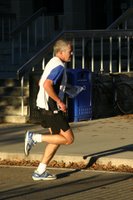 I got home from the North American O' Champs late last night. I'm still a bit worn out from the travel and running. I'll just jot down a few notes about the events. I got home from the North American O' Champs late last night. I'm still a bit worn out from the travel and running. I'll just jot down a few notes about the events.We began with a sprint race on the McMaster Campus. Despite not being very good at sprint orienteering, I enjoy it for the most part. Eddie B. took some snapshots, which I've copied and posted (I hope that is ok, Eddie). In the first photo, I'm struggling, feeling tired, about 2/3rds of the way through the course. I like the second photo, passing by a hot dog stand. 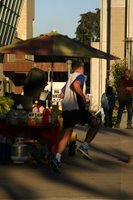 GHO did a great job organizing the race. I won't get into details, but I think the organizers' made a decision to put on the kind of event they'd like to run in - to go beyond meeting the normal standard of a national event and to make it a special event. I think they succeeded. Three very nice touches: (1) when you crossed the finish line, someone handed you an apple and a bottle of water, (2) they had a PA system and mixed music, announcements and interviews - very nice, makes the race feel like a big event, (3) every competitor got a chair!  The idea behind the chairs was that if everyone had a little folding chair, they'd be able to fill up the area around the finish chute and you'd get a really good event environment. I don't know who had the idea, but it was a great one (even if a lot of people ended up sitting on their Ikea chairs in the parking area or by the food stand). Mostly, I think it reflects some interesting, and good, thinking by the organizers. The idea behind the chairs was that if everyone had a little folding chair, they'd be able to fill up the area around the finish chute and you'd get a really good event environment. I don't know who had the idea, but it was a great one (even if a lot of people ended up sitting on their Ikea chairs in the parking area or by the food stand). Mostly, I think it reflects some interesting, and good, thinking by the organizers.Patrick will be glad to find out that Mary and I got two Ikea chairs - one pink, one blue. posted by Michael | 8:06 PM Thursday, October 05, 2006 If I were a virtual orienteerBefore I forget, the next planned update to this page will be on Monday, October 9. I'm going to the North American Champs and don't plan to take a computer with me.Before I left, I also went to Omanager and entered my teams for this weekends virtual relay race. In Omanager, each of your runners has an age and 12 characteristics that determine how they respond to training and how they race. If I were a virtual orienteer, going into this weekend's races, I'd look like this (scored on a scale of 0-17): Age: 42 Running in the forest: 6 (not enough running in the terrain for this number to be better). Running on roads: 8 Running hills: 7 (not bad and going in the right direction...but the terrain for the races this weekend isn't hilly, so it doesn't really matter much). Stamina: 8 Pace: 7 Form: 6 Day orienteering: 8 (might give myself a 9 for the sprint) Night orienteering: 6 (not that it matters, there are no night races this weekend) Orienteering experience: 13 (finally, being old pays off!) Motivation: 11 Injury form: 10 (higher is better, but I'm still feeling a turned ankle from the sprint finals and will run with an Active Ankle this weekend). Comfort: 12 Looking forward to the races, I'd have to say two things: "Not ready for a great performance, but should be able to manage a decent set of races" "It should be fun" posted by Michael | 1:24 PM Wednesday, October 04, 2006 Can you predict booms?A few years ago I had this idea that I could figure out a way to look at a course and predict which controls runners would boom.I started by looking at courses and just picking the 2 or 3 controls that I thought looked most likely to be boomed. That didn't work. I tried to go the other way around, looking at splits, figuring out which controls people boomed, then looking at the course and seeing what it was about those controls that lead to mistakes. I figured I could find common causes for booms. That didn't work. I tried to be systematic - collecting info about each leg, then seeing if some features of legs were correlated with booms. That didn't work. I tried reading what good orienteers had to say about their booms. That gave me a clue. Lots of booms happened when the map was misleading (e.g. the forest was shown as white, but was actually thick). I never learned to predict booms.* Which is, I suppose, something I learned. When I was trying to predict mistakes, I wasn't looking at sprint courses. I wonder if I could predict mistakes on sprint courses? It might be more practical because there are a couple of relatively common sprint-specific types of problems. One type is the skipped control. For example, on the map below it might be possible to either run from 17 to 19 or run from 18 to 20. The other type is the missed uncrossable feature. For example, on the map below it'd be fairly easy to lose time on the way to 3 if you didn't see how far off the straight line you need to go to get over the uncrossable fence. 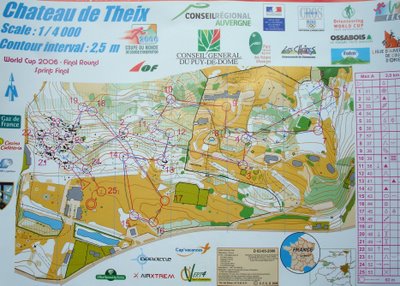 The map is from the French world cup sprint race, with Daniel Hubmann's routes. *I should point out that I was trying to predict when elite orienteers would boom. I suspect that predicting booms for average orienteers might be easier. posted by Michael | 7:39 PM Tuesday, October 03, 2006 Captured on filmI was going to write something about the French world cup race...or maybe some ideas for orienteering at the North American champs...or maybe something about the O' game "Omanager."My plans changed when I came across the white squirrel while I was running this evening. I've spotted the white squirrel several times. But, I'd never before managed to get a snapshot. So, I was psyched to get a couple of snapshots even if the quality isn't so good.  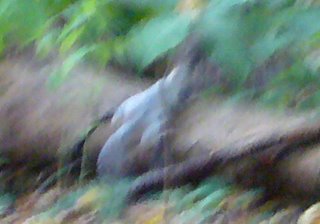 The quality of the photos isn't great. The light in the forest was not very good. The squirrel was moving away from me. I used the digital zoom. That was probably a mistake. I had to work quickly before the squirrel ran away. posted by Michael | 8:14 PM Monday, October 02, 2006 Confused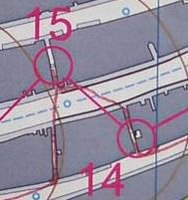 I like sprint orienteering. Or maybe I just think I like sprint orienteering. Maybe I'm confused. I like sprint orienteering. Or maybe I just think I like sprint orienteering. Maybe I'm confused.Maybe the sprint courses from the Post Finance sprint in Switzerland are more interesting than they look at first glance. The courses have lots of direction changes and variety in leg lengths. The runners faced lots of route choice problems (like the little leg above). But, as I look at the maps (with Oystein Kvaal Osterbo's routes), I just don't have the feeling of -- wow, wouldn't that be fun.  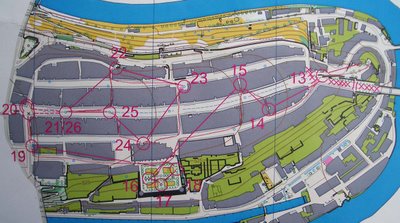 I don't know. Maybe I need to look more carefully. Or maybe I'd appreciate the courses more if I put myself in the shoes of the course setter and tried to do better. I'm quite sure I couldn't do better. Maybe I should just look at a different map, like Oystein Kvaal Osterbo's routes on the middle distance qualifying race from the World Cup in France. posted by Michael | 7:21 PM Sunday, October 01, 2006 Comparing mapsI was looking at some old maps, including a map from a snowy training camp in Uppsala. As I was looking at it, I realized it covered the same terrain as the ultra-sprint maps I've seen. Compare the 1:15,000 O' map (1991) to the ultra-sprint maps.   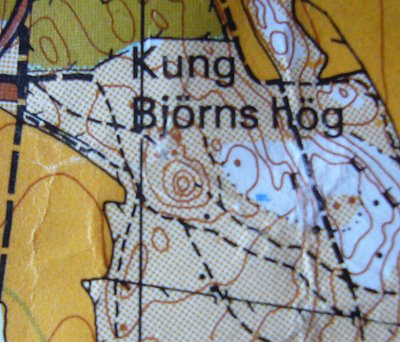  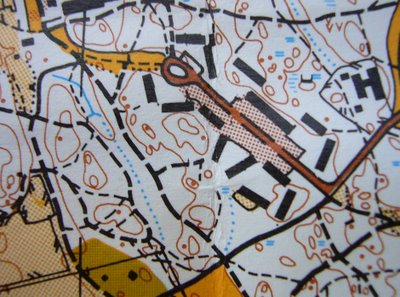 posted by Michael |
5:04 PM
posted by Michael |
5:04 PM |
|
||||
|
|
|||||